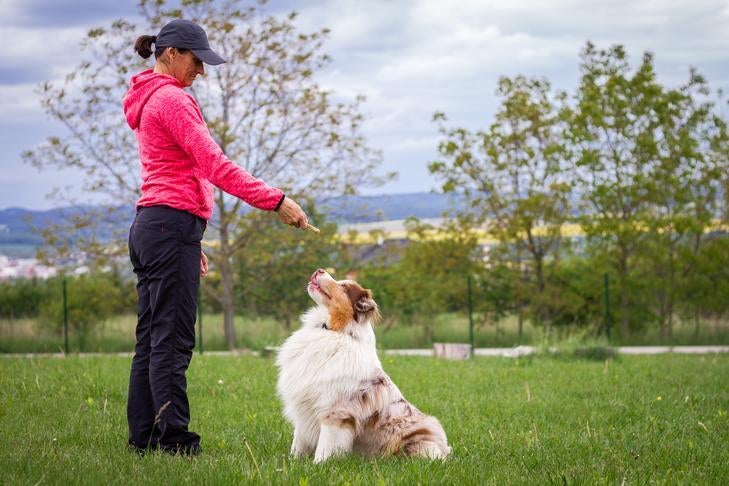Master Essential Commands: Effective Pet Training Facilitated
Reliable pet training is a basic element of responsible animal possession, and grasping essential commands offers as the foundation for an unified partnership between trainer and pet. Understanding the subtleties of canine habits and the training process is vital; nonetheless, the journey to a well-trained pet usually presents unexpected difficulties that need interest.
Comprehending Your Canine's Actions
To realize the subtleties of efficient canine training, it is vital to break down and evaluate your dog's habits. Dog training. Recognizing the motivations behind your dog's activities is vital; habits can originate from impulse, anxiety, excitement, or a wish for attention. By observing your pet dog in numerous situations, you can determine patterns that might indicate underlying feelings or needs
For circumstances, a pet that barks excessively may be revealing dullness, stress and anxiety, or a need for social interaction. On the other hand, a pet that exhibits damaging habits could be looking for excitement or relief from anxiety. Identifying these triggers allows you to tailor your training strategy efficiently.
Furthermore, it is vital to think about the pet dog's type features, as they can influence actions significantly. Some breeds are inclined to certain attributes, such as herding or securing impulses, which can influence their responses to particular stimulations.
Last but not least, uniformity in your actions to your dog's behavior fosters a better understanding in between you and your pet dog. This common understanding is fundamental for constructing trust fund and facilitating a reliable training procedure that supports both behavioral modification and favorable reinforcement.
Vital Commands to Show
Instructing vital commands is a fundamental element of effective pet training, supplying the foundation for a well-behaved and receptive family pet. These commands not only boost interaction in between the proprietor and the pet dog but also make sure safety in various settings.
The most important commands include "Sit," which urges your pet to stay stationary and tranquil; "Remain," which reinforces the concept of staying in one location till launched; and "Come," which is vital for remembering your canine from possibly hazardous circumstances. "Down" shows pets to rest, advertising relaxation and control, while "Leave it" aids avoid dogs from grabbing damaging or undesirable products.
" Heel" is an additional essential command that motivates your canine to stroll closely next to you, improving leash good manners. Lastly, "No" offers as an important boundary-setting command, helping to remedy undesirable habits.
Training Techniques for Success
Efficient pet training you can find out more relies greatly on employing a range of strategies that accommodate both the canine's understanding style and the owner's training objectives. One key method is favorable support, which involves gratifying desired habits with deals with, appreciation, or play. This method encourages the canine to duplicate those habits, fostering a solid bond between proprietor and pet dog.

One more efficient technique is remote control training, where an unique noise, made by a remote control, marks the specific minute a pet dog does a preferred activity. This precise timing helps Read Full Article dogs associate the actions with the benefit, improving their understanding.
Consistency is essential in all training methods. Establishing clear commands and keeping the exact same cues helps the pet grasp assumptions more quickly. Additionally, brief, interesting training sessions protect against monotony and increase retention.
Integrating socialization possibilities is likewise important. Exposing canines to various settings, people, and various other pets helps them create confidence and adaptability.
Last but not least, perseverance plays a substantial function in effective training - Dog training. Each pet dog learns at their own speed, and comprehending this can lead to a much more enjoyable training experience for both the proprietor and the canine. Executing these strategies will establish the foundation for efficient dog training
Typical Challenges and Solutions
Regardless of the ideal training strategies, pet owners frequently experience typical difficulties that can impede progress. When family members use different commands for the same actions, it perplexes the pet, leading to irregular actions.

Additionally, some pets may display stubbornness or lack motivation. This can frequently be addressed by including positive support strategies, such as deals with or praise, to urge desired actions. Tailoring benefits to what your pet finds most inspiring can significantly improve their involvement.
Finally, anxiety or stress and anxiety can restrain development in training. Recognizing indications of stress and changing the training speed as necessary is important. Using gradual exposure to been afraid stimuli can help develop self-confidence over time, assisting in an extra efficient training experience.
Keeping Consistency and Patience
Uniformity and perseverance are extremely important in canine training, as they develop the structure for attaining long lasting behavioral modifications. Pet dogs grow on regular and clear assumptions; thus, maintaining a constant technique in commands, incentives, and improvements is important. When fitness instructors utilize the exact same signs and signals reliably, canines are better able to comprehend what is being asked of them. Incongruity can lead to confusion and irritation, undermining the training process.
Pets, much like human beings, have varying finding out paces and might not understand commands immediately. Positive reinforcement plays a vital function below, gratifying wanted actions and assisting to foster a trusting partnership in between the pet dog and fitness instructor.
Final Thought
Mastering necessary commands is fundamental to efficient content pet training, fostering enhanced interaction and reinforcing favorable behaviors. The application of positive support strategies, coupled with consistency and persistence, significantly boosts the training experience for both the canine and trainer. Addressing common difficulties with sensible solutions even more supports the training procedure. Ultimately, a well-trained pet dog not just shows good behavior but additionally develops confidence, adding to an unified partnership in between the dog and its owner.
Comments on “Professional Obedience training services for all dog breeds.”